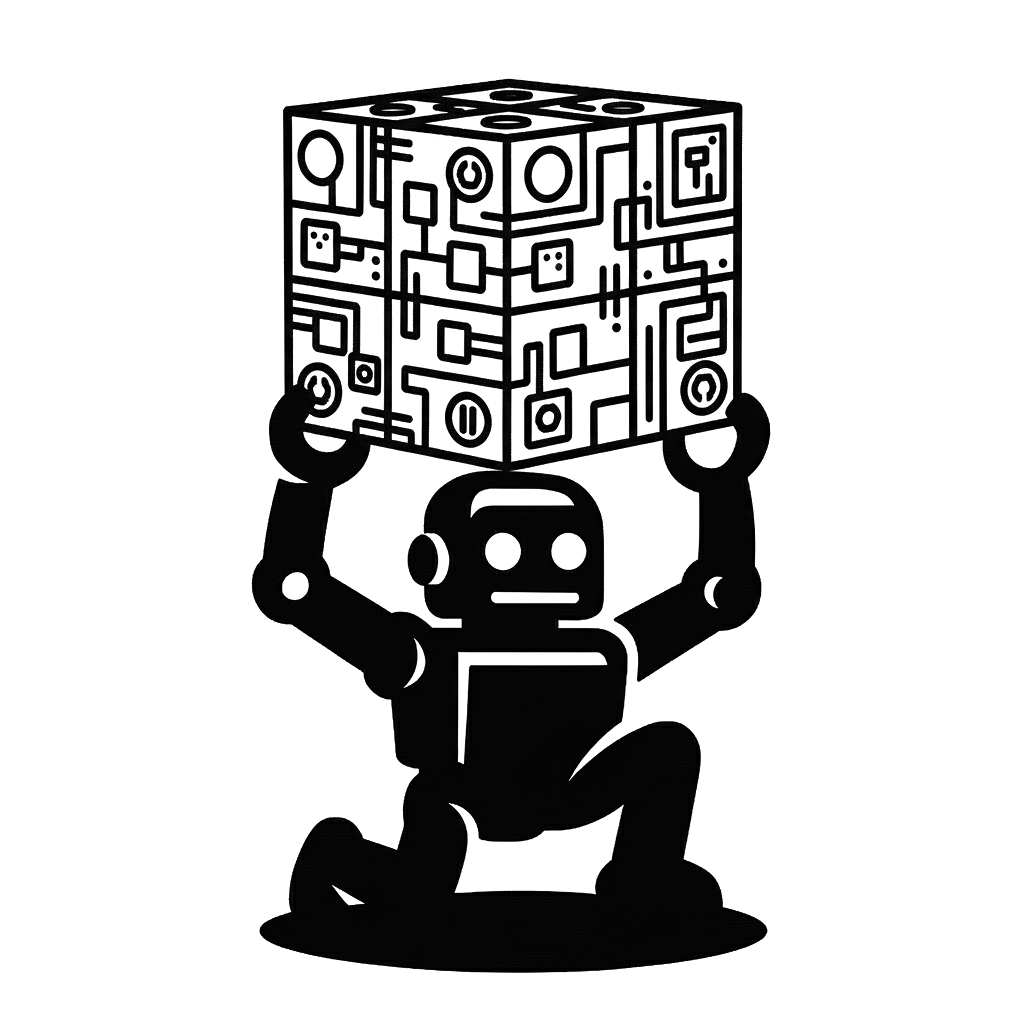Using Transformations#
This tutorial introduces the mathematical idea of rigid-body transformations and how to use our TransformationMatrix to place and move things in a world.
You will learn:
What a rigid transform is (position + orientation)
How to create transforms using
TransformationMatrix.from_xyz_rpyHow to compose transforms using the
@operator (parent_T_child style)How the
reference_frameparameter determines which axes a motion is expressed in
At the end, you should be confident to complete the exercise: Using Transformations.
Note
Notation: We follow the style A_T_B for “pose of B in the frame of A”. This is explained in our style guide and makes composition readable.
0. Setup a tiny world#
We will create a simple world with a square base plate and a small camera box mounted on top of it. We will position the base in the world, then attach the camera relative to the base.
from semantic_digital_twin.datastructures.prefixed_name import PrefixedName
from semantic_digital_twin.spatial_types.spatial_types import TransformationMatrix
from semantic_digital_twin.world import World
from semantic_digital_twin.world_description.world_entity import Body
from semantic_digital_twin.world_description.shape_collection import ShapeCollection
from semantic_digital_twin.world_description.geometry import Box, Scale, Color
from semantic_digital_twin.world_description.connections import Connection6DoF
from semantic_digital_twin.spatial_computations.raytracer import RayTracer
import math
world = World()
# Create an explicit root body like in other examples, so we can attach our base
root = Body(name=PrefixedName(name="root", prefix="world"))
# Geometry for a square base plate and a "camera" box
base_plate_shape = Box(scale=Scale(0.6, 0.6, 0.05), color=Color(0.3, 0.3, 0.3, 1.0))
camera_shape = Box(scale=Scale(0.10, 0.06, 0.05), color=Color(0.1, 0.2, 0.8, 1.0))
base_body = Body(
name=PrefixedName(name="base", prefix="transform_example"),
visual=ShapeCollection([base_plate_shape]),
collision=ShapeCollection([base_plate_shape]),
)
camera_body = Body(
name=PrefixedName(name="camera", prefix="transform_example"),
visual=ShapeCollection([camera_shape]),
collision=ShapeCollection([camera_shape]),
)
# Connect base to the world root, and camera to the base.
world_C_base = Connection6DoF(parent=root, child=base_body, _world=world)
base_C_camera = Connection6DoF(parent=base_body, child=camera_body, _world=world)
# Place the base: put it slightly above the ground so the top sits at z≈0.05
world_T_base = TransformationMatrix.from_xyz_rpy(z=0.025, reference_frame=root)
# Place the camera relative to the base: forward along base-y and a bit upward, yawed by +30°
base_T_camera = TransformationMatrix.from_xyz_rpy(
y=0.25,
z=0.10,
yaw=math.radians(30),
reference_frame=base_body,
)
with world.modify_world():
world.add_connection(world_C_base)
world.add_connection(base_C_camera)
# Set origins in a separate modification block so FK is compiled first
with world.modify_world():
world_C_base.origin = world_T_base
base_C_camera.origin = base_T_camera
# Visualize
rt = RayTracer(world)
rt.update_scene()
rt.scene.show("jupyter")
1. What is a transform?#
A rigid transform is a mapping between two Cartesian coordinate frames. It has:
Translation: x, y, z (meters)
Rotation: roll, pitch, yaw (radians), where
roll = rotation about x
pitch = rotation about y
yaw = rotation about z
Mathematically it is a 4×4 homogeneous matrix. Our TransformationMatrix wraps these values and provides convenient factories like from_xyz_rpy(...).
# Compose transforms: world_T_camera = world_T_base @ base_T_camera
world_T_camera = world_T_base @ base_T_camera
print(
"Camera position in world frame:",
"x=%.3f" % float(world_T_camera.x.to_np()),
"y=%.3f" % float(world_T_camera.y.to_np()),
"z=%.3f" % float(world_T_camera.z.to_np()),
)
Camera position in world frame: x=0.000 y=0.250 z=0.125
/tmp/ipykernel_734/3170003538.py:5: DeprecationWarning: Conversion of an array with ndim > 0 to a scalar is deprecated, and will error in future. Ensure you extract a single element from your array before performing this operation. (Deprecated NumPy 1.25.)
"x=%.3f" % float(world_T_camera.x.to_np()),
/tmp/ipykernel_734/3170003538.py:6: DeprecationWarning: Conversion of an array with ndim > 0 to a scalar is deprecated, and will error in future. Ensure you extract a single element from your array before performing this operation. (Deprecated NumPy 1.25.)
"y=%.3f" % float(world_T_camera.y.to_np()),
/tmp/ipykernel_734/3170003538.py:7: DeprecationWarning: Conversion of an array with ndim > 0 to a scalar is deprecated, and will error in future. Ensure you extract a single element from your array before performing this operation. (Deprecated NumPy 1.25.)
"z=%.3f" % float(world_T_camera.z.to_np()),
Note
Composition order matters. parent_T_child @ child_T_grandchild yields parent_T_grandchild. The result is expressed in the left-most frame (here: world).
2. Move along local vs. world axes#
Suppose we want to move the camera 0.1 m forward along its own x-axis and rotate it an additional 45° about its own z-axis. To express a motion in the camera’s local axes, create the offset with reference_frame=camera_body.
# Move and rotate in the camera's own frame
camera_T_camera_offset = TransformationMatrix.from_xyz_rpy(
x=0.10, # forward along camera-x
yaw=math.radians(45), # about camera-z
reference_frame=camera_body,
)
# Update the connection origin in the base frame by composing on the right
base_T_camera_moved = base_T_camera @ camera_T_camera_offset
with world.modify_world():
base_C_camera.origin = base_T_camera_moved
rt = RayTracer(world)
rt.update_scene()
rt.scene.show("jupyter")
3. Reposition the base and see the chain update#
If we rotate the base in the world by 90° yaw, the camera comes along because its pose is defined relative to the base.
# Pure rotation in the base frame (no translation)
base_T_base_rot = TransformationMatrix.from_xyz_rpy(yaw=math.radians(90), reference_frame=base_body)
new_world_T_base = world_T_base @ base_T_base_rot
with world.modify_world():
world_C_base.origin = new_world_T_base
rt = RayTracer(world)
rt.update_scene()
rt.scene.show("jupyter")
Where to go next#
Style guide on transformations and naming: https://cram2.github.io/semantic_digital_twin/style_guide.html
API docs for
TransformationMatrix: https://cram2.github.io/semantic_digital_twin/autoapi/semantic_digital_twin/spatial_types/spatial_types/index.html#semantic_digital_twin.spatial_types.spatial_types.TransformationMatrixNow try the exercise: Using Transformations
